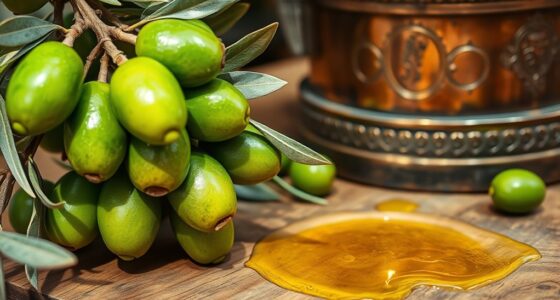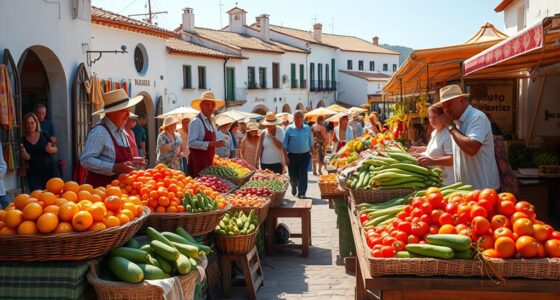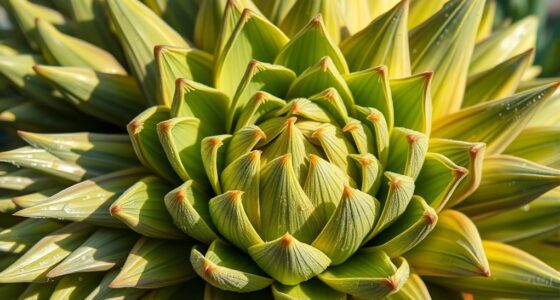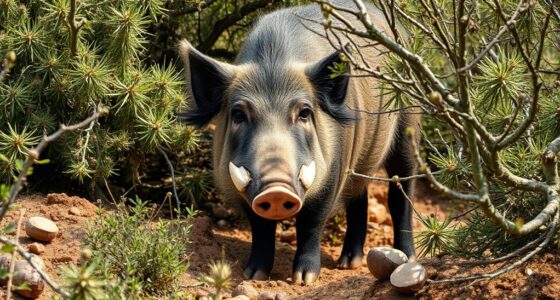Local honey and beekeeping traditions vary worldwide, shaped by native materials, climate, and cultural beliefs. You might find communities using hollowed logs, clay pots, or wooden boxes to hive bees, often integrating spiritual rituals and local resources. These methods influence honey quality and the community’s connection to nature. Understanding these diverse practices offers a fascinating glimpse into how humans have historically cherished and protected bees—stay tuned for more insights into this rich heritage.
Key Takeaways
- Indigenous communities often use locally sourced materials like bark and hollow logs for traditional hive construction.
- Regional techniques include seasonal hive movement and specific harvesting rituals linked to cultural beliefs.
- Honey is culturally valued as sacred, symbolizing fertility and divine energy across diverse traditions.
- Traditional practices emphasize harmony with nature, using local flora and sustainable methods to support bee populations.
- Beekeeping rituals and ceremonies reinforce social cohesion and spiritual connections with bees and honey.
Overview of Traditional Beekeeping Practices Around the World

Traditional beekeeping practices worldwide showcase a rich diversity rooted in cultural, environmental, and technological factors. In ancient Egypt, you’d find cylindrical clay and pottery hives designed to minimize disturbance during honey harvesting. Ancient Greece elevated beekeeping to a high-status craft, using specialized tools like honey extractors and smoking pots, as documented by Aristotle. In China, sophisticated wooden box hives with quality timber influenced honey quality and hive longevity. The Maya developed meliponiculture, raising stingless bees for honey and fermented drinks, by 300 BCE. In Eastern Europe, traditional tree beekeeping involved carving hives into centuries-old pines and larches. Nomadic practices in Central Asia and Kenya show movement of hives to match flowering cycles and protect bees. Across regions, natural materials like bark, logs, and clay shape sustainable, culturally embedded beekeeping traditions. Natural materials like bark, logs, and clay are often chosen for their insulating properties and availability in local environments, reinforcing the sustainability of these practices. Additionally, some cultures incorporate traditional harvesting methods that emphasize minimal disruption to the hive and the environment.
Regional Beekeeping Techniques and Local Materials
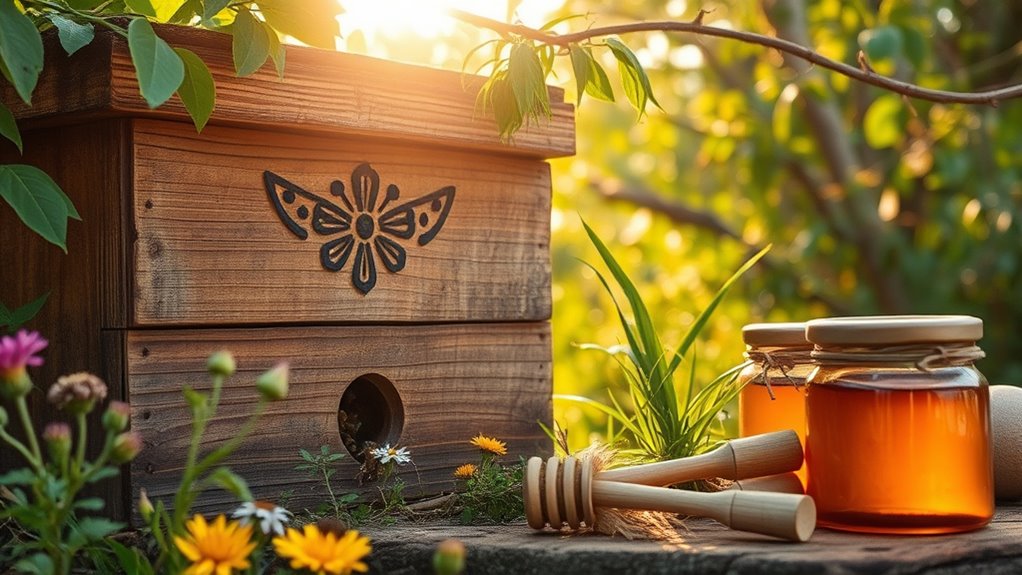
Across different regions, beekeepers adapt their techniques to local environments by using readily available materials, which influence hive design and management. In Africa, traditional log hives are carved from hollowed logs and hung from trees to protect bees from predators. Traditional log hives are among the oldest forms of beekeeping, dating back thousands of years. The Kenyan Top-Bar Hive offers a sustainable alternative, combining traditional shape with modern practices. In Uganda, bark hives made from local tree bark create eco-friendly homes that support bee health. Nomadic African beekeepers move hives seasonally to follow flowering plants, optimizing honey yields. Elsewhere, brick hives with simple wooden entrances reflect local construction methods. These materials—wood, bark, brick—are sourced locally, reducing costs, matching climate needs, and fostering ecological harmony, all while maintaining effective honey production and hive longevity. Local materials influence the resilience and adaptability of beekeeping practices across diverse environments.
Impact of Hive Types on Honey Quality and Production
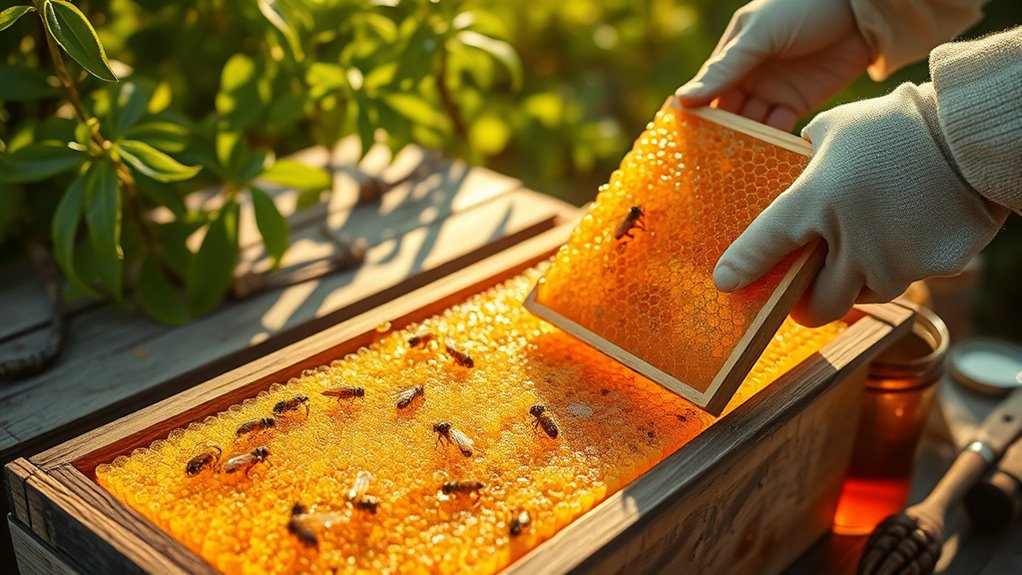
The type of hive you choose directly influences honey quality and how much honey you can produce. Langstroth hives, with stacked boxes, allow you to expand honey storage and increase yields, especially when managing colonies with 8 or more frames. Top bar hives offer limited space, risking swarming and potentially reducing honey stores. Horizontal hives like Layens use side-by-side combs, but may be less space-efficient. The hive material also matters: wooden hives like Langstroth and WBC provide a natural environment that stabilizes temperature and affects honey consistency, while BPA-free plastic in Flow Hives doesn’t alter honey flavor. Proper hive design, ventilation, and management ease all impact honey quality and quantity, with healthier colonies producing better, more consistent honey.
Cultural Significance of Honey and Beekeeping in Communities
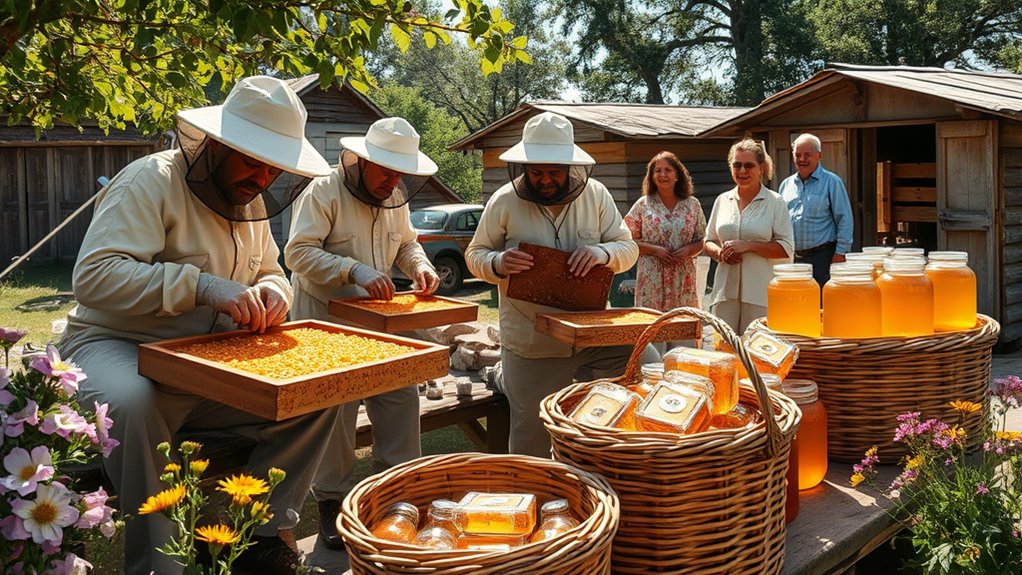
Honey and beekeeping hold deep cultural significance that goes beyond their practical uses. Throughout history, many communities see honey as sacred, symbolizing fertility, life, and divine energy. You might participate in rituals where honey is offered to gods or used as sacred currency, connecting spiritual beliefs with daily life. Beekeeping rituals often include blessings, prayers for bees’ health, and aligning hive inspections with religious calendars. Indigenous groups, like the Xhosa and Maya, see bees as messengers from ancestors or divine beings, integrating honey into ceremonies and cultural practices. Honey’s role extends to economy and social cohesion, serving as tribute, a communal resource, and a symbol of abundance, reinforcing community bonds and spiritual connections across generations. Historical traditions of honey continue to influence contemporary spiritual practices and community rituals, emphasizing the importance of cultural symbolism in maintaining these age-old traditions.
Challenges and Opportunities in Preserving Beekeeping Heritage
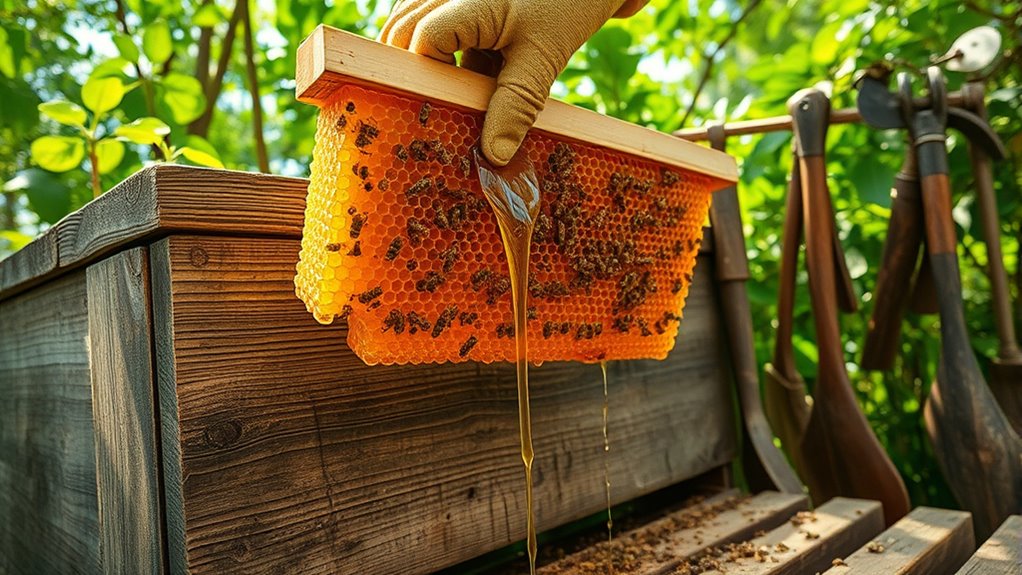
Preserving beekeeping heritage faces significant hurdles as modern challenges threaten traditional practices and the health of indigenous bee populations. Colony losses are soaring, with U.S. beekeepers losing up to 62% of their colonies, leading to economic impacts exceeding $600 million. Winter losses hit a record 40.2%, endangering the sustainability of many operations. Parasites like *Varroa destructor* and viruses, along with pesticide exposure and habitat loss, weaken bee health and reduce natural forage. These issues make it harder to maintain traditional beekeeping methods and threaten indigenous bees. Recent surveys report over 1.9 million colonies lost in the current period, highlighting the severity of the crisis. Efforts to improve disease management and implement sustainable practices are crucial for recovery. Yet, opportunities exist through research, habitat restoration, and community support. Embracing sustainable practices and fostering awareness can help safeguard this heritage, ensuring that both cultural techniques and crucial pollinator populations endure for future generations.
Frequently Asked Questions
How Do Traditional Beekeepers Identify Hive Health Issues Without Modern Tools?
You can spot hive health issues by observing bee behavior and hive appearance. Watch for decreased activity, irregular brood patterns, or abnormal odors. Use a smoker to calm the bees and inspect combs for damage or disease signs. Listen for unusual hive sounds, check for dead bees at the entrance, and monitor for pests like mites. These traditional methods help you detect problems early without relying on modern tools.
What Are the Most Common Local Materials Used for Building Traditional Beehives?
Ever imagine building a hive with what’s nearby? You’ll find mud mixed with straw and dung, shaped into cylinders or used as coatings for insulation. Clay tiles, bricks, or stone help with durability and temperature control. Wood, especially pine, forms frames and hives. Cow dung and mud protect from weather, while organic materials like straw add strength. These local choices create sturdy, climate-adapted homes for bees.
How Does Honey Harvesting Differ Between Traditional and Modern Beekeeping Methods?
You’ll notice that traditional honey harvesting involves removing entire combs, often destroying the structure and disturbing the bees considerably. In contrast, modern methods use movable frames and specialized equipment like centrifugal extractors or Flow Hives, allowing you to harvest honey more efficiently and with less disruption. This approach maintains hive health, produces cleaner honey, and boosts yields, making honey collection faster, easier, and more sustainable.
In What Ways Do Cultural Beliefs Influence Honey Harvesting and Usage?
You see, cultural beliefs turn honey into more than just a sweet treat; it’s a symbol of divine blessing, prosperity, and spiritual connection. When you harvest honey, you honor traditions, respect nature, and uphold sacred rituals. Whether used in ceremonies or as medicine, these beliefs shape how you perceive its value, making honey a vessel of cultural identity and communal harmony, enriching every drop with deeper meaning beyond its taste.
Are There Specific Rituals Associated With Honey Collection in Different Communities?
You’ll find that many communities have unique rituals for honey collection. For example, in Nepal’s Himalayan regions, a shaman picks an auspicious day, performs ceremonies, and releases smoke to guarantee safety. Indigenous groups in Central America honor spirits with offerings during harvest, while Southeast Asian communities follow seasonal sacred journeys. These rituals show respect for nature, promote safety, and deepen cultural bonds through symbolic acts during honey gathering.
Conclusion
You might think modern methods have replaced traditions, but preserving local beekeeping keeps cultural heritage alive and supports biodiversity. By embracing traditional practices, you not only enjoy unique honey flavors but also help protect bees and their ecosystems. Don’t underestimate the value of these time-tested techniques—they hold the key to sustainable honey production and cultural richness. Keep the tradition thriving; your involvement makes a difference for future generations.


